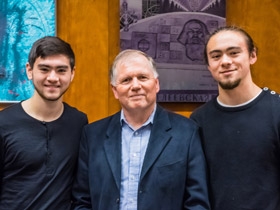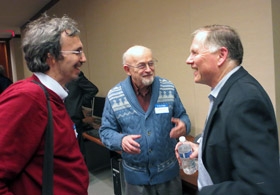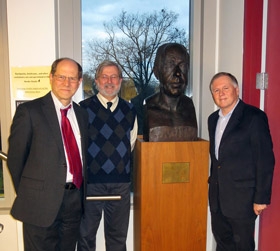On January 15 the American Institute of Physics hosted the first Lyne Starling Trimble Science Heritage Lecture of 2014 at the American Center for Physics. Dr. Vilhelm Bohr presented a very personal view of his grandfather in his lecture, “Niels Bohr: Life Behind Physics.” The attentive audience of 92 was treated to insights from Vilhelm Bohr’s childhood experiences with his remarkable grandfather and especially with his grandmother, Margrethe (Nørlund) Bohr.

Physics runs in the Bohr family. Niels Bohr famously proposed his atomic model 101 years ago in 1913. For this he received the Nobel Prize in 1922, “for his services in the investigation of the structure of atoms and of the radiation emanating from them.” His father before him was a professor of physiology. His brother was a mathematician. His son Aage received the Nobel Prize in Physics in 1975. (Three other sons became a medical doctor, a lawyer, and an engineer. Niels and Margrethe had six sons, two of whom died young.) His grandson Vilhelm, our speaker, with doctoral degrees in medicine and science, is branch chief at the NIH National Institute on Aging. His brother Tomas is a physics professor in Copenhagen, and Vilhelm’s sons are interested in physics. Vilhelm Bohr spoke eloquently about his grandfather and about the remarkably accomplished family that surrounded him, but especially about Margrethe, constant confidant and advisor of Niels.
Margrethe Nørlund and Niels Bohr married in 1912 outside of the Danish Lutheran Church in a civil ceremony. They were both uneasy about the official status of the religion. Niels’ mother, Ellen (Adler) Bohr, came from a prominent Danish-Jewish banking family, and it is well known that Niels and Margrethe helped many Jewish scientists escape German authorities. Ultimately, they, too, escaped to the United States via Sweden.
Last year was of course a very big year in Denmark, in observance of the centenary of Bohr’s theory of the atom. In June, a conference on the history of physics convened in the assembly hall of the Danish Academy of Science. There were art exhibits, a performance of the play “Copenhagen,” a conference on quantum physics, and lastly, a high-level, wide-ranging conference that focused on Bohr’s concept of “An Open World.”

Vilhelm Bohr related to us the great enthusiasm produced by all of these events and the hopes they raise for the future. Another “Open World” conference is being planned to take place in Brazil, and a new “Open World Letter” will be presented to the United Nations, carrying forward the ideals expressed by Niels Bohr in his 1950 open letter to the UN. Another result will perhaps not appear in headlines but will have a direct connection to AIP. The Niels Bohr Institute in Copenhagen has the Niels Bohr Archive, now consisting mainly of the papers and correspondence of Niels Bohr. The archive’s board (of which Vilhelm is chair), however, intends to broaden the collection and to elevate the archive to become a more active center for scholarly exchange. Fred Dylla, AIP’s CEO, toured the archive last summer with its director, Finn Aaserud. The History Programs at AIP—the Center for History of Physics and our similarly named Niels Bohr Library and Archives—look forward to exploring ways that our two institutions can work together to take advantage of new opportunities in the years ahead.

AIP was fortunate to have this opportunity to host Dr. Vilhelm Bohr and his family and to provide a forum for putting his memories and dreams before a larger public.
There is at the moment one more Lyne Starling Trimble lecture scheduled for 2014. This will be our first lecture outside the Washington, DC, area. On May 7, the 2014 recipient of the APS-AIP Pais Prize for History of Physics, Professor David Cassidy (Hofstra University), will present a staged reading of his play “Farm Hall.” This event will be held in Santa Fe, NM.
